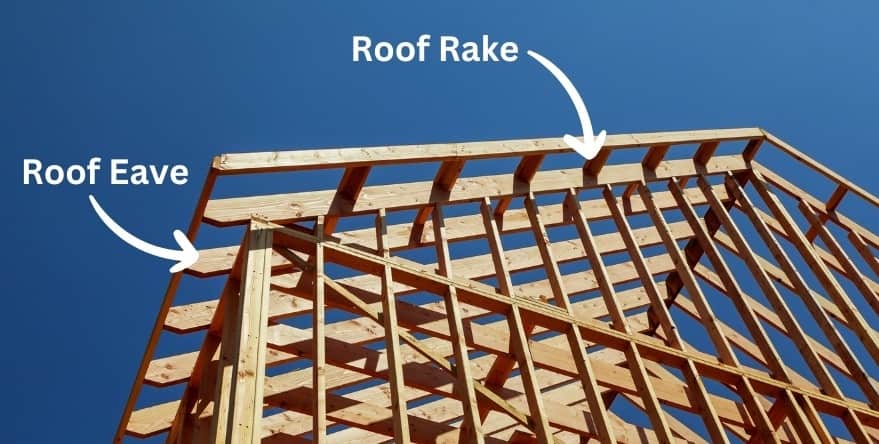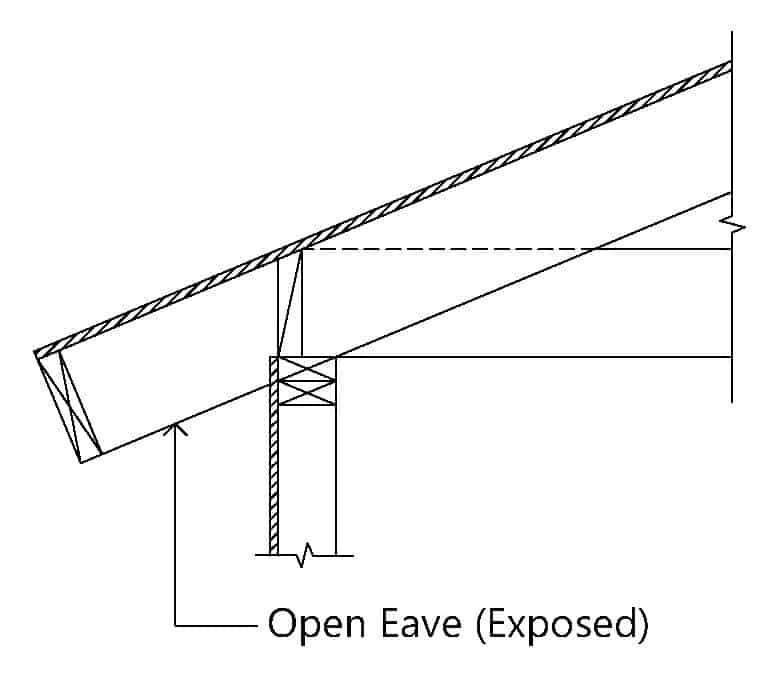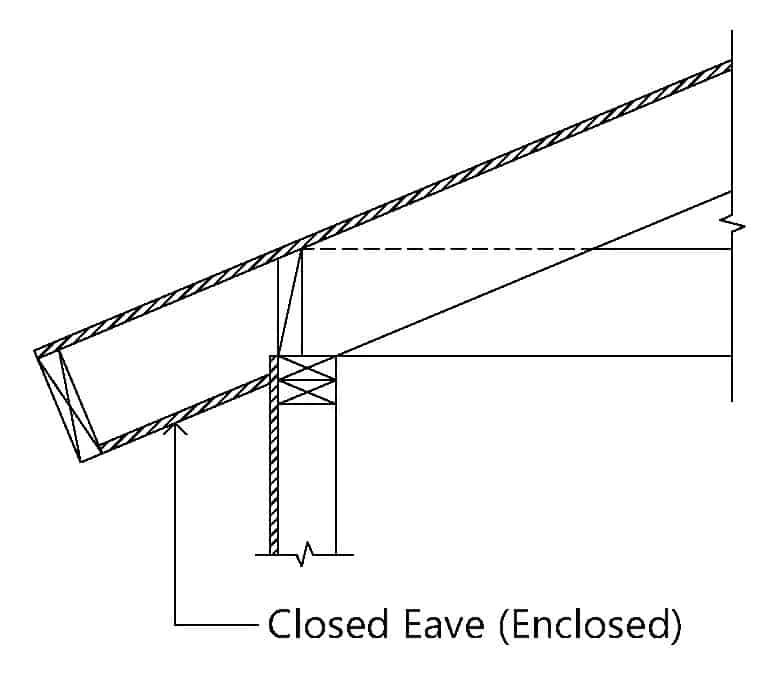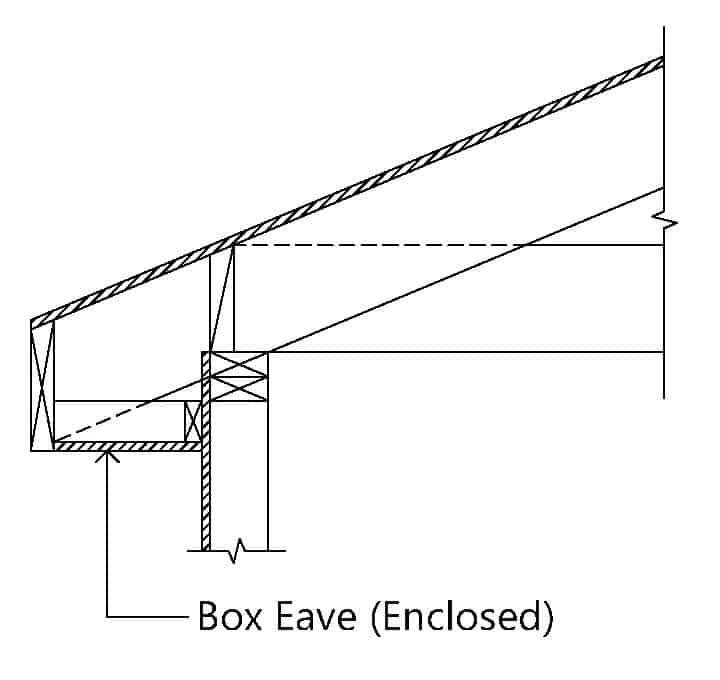When it comes to the anatomy of your roof, it might seem like there’s not much going on. But when you look closely, you will see that it is made up of various parts. There’s the ridge, gable, rake, eave, hip, and many more involved.
It’s important to have an understanding of roof elements. Knowing the anatomy of a roof and its terminology is important. At first glance, one might not take into account the details that go into the anatomy of a roof.
One of these elements that we will discuss here is an important one called the Eave.
What are Eaves on a House?
The roof eave is an extension of the roof rafters that overhang the exterior wall which is found on the sloping side of a roof’s edge providing an overhang for protection against the elements. It’s a common architectural style found on many houses, regardless of the roof type. In some cases, the eaves may be decorative, while in most cases they functionally serve a purpose.
One important thing to note here is not to confuse a roof eave with a roofs rake end. Although very similar, the roof rake is an extension of the roof at the gable roofs end while the roof eave is an extension of the roof rafters that overhang the exterior walls at the sloped side.

Fun Tip: To learn what the rake of a roof is, be sure to check out this POST.
Roof Eave Code Requirements
Section R802.7.1.1 of the International Residential Code (IRC) is a code section that talks about roof eaves of residential homes subject to the IRC. This code section is titled, “Cantilevered Portions of Rafters” because that is what a roof eave is, the cantilevered portion of a roof rafter.
The only two things that are discussed in this section regarding rafter eaves, is the limitation to how much they can be notched when resting on the top plate and the maximum length of a rafter eave.
Notching
In the construction industry, the notching of rafters at the eave can also be known as the “birdsmouth cut“. This cut allows the rafter to rest correctly onto the supporting wall. There is a limit to how much you can cut to ensure the rafters structural integrity is not compromised.
Length
As for the maximum length, the code limits it to 24 inches.
One important thing to note here is that this limitation is placed when you are using the prescriptive span tables within the IRC to determine the size of the roof rafter.
Fun Tip: To learn how to size roof rafters per the IRC, be sure to check out this POST.
However, when you are using an engineered method to calculate the size of a rafter and not the prescriptive tables found in the IRC, you are not bound by the maximum length limitation found in this section.
What Do Roof Eaves Do?
Having eaves on a house can be beneficial in many ways. Aside from providing an aesthetically pleasing look, they also provide protection to the home against harsh weather conditions such as rain and snow. But that’s not all; let’s take a closer look at some of the other useful functions of roof eaves.
1. Adds Depth and Definition to the Home
Beyond its functionality, eaves are often added to roofs to make the home look deeper, creating a sense of depth. The roof overhangs create an illusion of the roof extending further away, which can do wonders for making one’s house stand out from its surroundings. However, this aesthetic feature is an added bonus. The eaves’ primary purpose is to protect the home from the elements.
2. Provides Protection from Weather Elements
Eaves are a great way to protect a home from rain and snow, as the overhang blocks these weather conditions from coming into contact with the walls where it intersects with the roof. Additionally, the eaves keep the sun’s rays from entering through windows and doors, possibly lowering indoor temperatures and your energy bill as a result.
3. Protects the Sidings and Home Structure and Foundation
The roof is considered to be one of the most vulnerable parts of a house, as it is prone to damage due to the weather. A poorly maintained roof, or one that is too old, can easily be damaged by rain or snow. Eaves provide extra protection to your roof, thus increasing its lifespan and reducing the need for maintenance and repairs.
When eaves are installed properly, they also help protect the wall covering of a house from water damage. This is important in preventing structural issues that could lead to costly repairs in the future.
4. Provides Shade
Depending on where you live, the sun can be extreme at certain times of the year. Having eaves installed on your house helps provide shade to both the interior and exterior spaces, especially during summer. This can keep the temperature of your home lower, allowing you to save on energy bills and keep cool inside.
5. Serves as an Unobtrusive Security Camera Mount
While roof eaves are not primarily designed for security purposes, they can be used as a mount for hidden security cameras. This unobtrusive placement is great for those who want to keep an eye on the outside of their house without compromising the aesthetics. With this extra bit of protection, you’ll have peace of mind knowing that your home is safe and secure.
What are the Different Types of Roof Eaves?
As roof eaves are integral in a roof’s structure and design, there are several types available for different roof types. The most common ones and basic types of eaves are the following:
Open Eave (Exposed)
An open eave (exposed eave) is an overhang where the rafters are exposed and visible to the public eye, making it an excellent choice for those looking for a more rustic appearance for their home. This type of eave allows air to circulate freely due to its open design and also helps protect from snow buildup during winter months. It’s important to note that open eaves are more vulnerable to water damage since they are exposed.

Open eaves tend to be more ornate than closed styles and can provide a decorative touch to any home exterior.
Closed Eave (Enclosed)
A closed eave is an overhang typically featuring a soffit that covers up the underside of the eave, creating a seamless and uniform look. Generally, soffited eaves are ideal for homes that are trying to achieve a more traditional or classic look to their exteriors. The main benefit of a closed eave is that it provides excellent protection against water damage; since there are no exposed rafters.

In some cases it might even be required in certain geographical areas when a structure is located in an area designated as a high fire zone. Closed eaves can provide a level of protection when certain types of materials are used. Different materials provide a different level of protection.
Box Eave (Enclosed)
Boxed-in eaves are quite similar to closed eaves. However, this type features an ornamental molding buildup around the undersides of the eaves, essentially “boxing in” the area so that no rafters are visible from below. This gives your roof line an elegant look while also providing excellent protection against water damage due to its enclosed design.

This type of overhang isn’t as common as either of the first two types but can still be seen in older homes and those looking for something unique and distinctive in terms of style and appearance.
What Type of Roof Flashing is Required at Eaves?
For your typical asphalt shingle roof and specifically at the roof eaves, a drip edge flashing is required per the International Residential Code. This type of flashing is a form of metal flashing, which is installed on the roofs edge to block water from entering the house, or getting under the roof.
Flashing is an integral part of the roof system and plays an important role by providing a waterproof barrier against water damage.
There are different types of roof flashing depending on the roofing material used. For example a roof that is covered with asphalt shingles may require a type of flashing that a metal roof would not.
Fun Tip: To Learn What Is A Drip Edge On The Roof and When Is It Required by Code, be sure to check out this POST.
Along with the flashing, gutters can also be necessary to protect your eaves from water damage. A gutter system helps to direct rainwater away from your home and into a safe place, thus preventing your eaves facia board from being damaged over time.
What are some Potential Problems of Roof Eaves?
Roof eaves provide a valuable service to homes and buildings, helping protect against water damage and other outdoor elements. While roof eaves are designed to be resilient and long-lasting, there can still be some potential problems that arise over time.
Sagging
Sagging is a common issue for roofs and their eaves, particularly if your building is older or your roof is made of heavier materials. Sagging occurs when the support structure beneath the eave gives out due to age or wear and tear, causing the area of the eave directly above it to droop downwards. This can cause an aesthetic issue, as well as a practical one, since sagging may lead to water pooling in certain areas of the roof. To prevent sagging, it’s important to inspect the support structure beneath your eave frequently and ensure that it is properly fortified against potential deterioration.
Clogged Gutters
Gutters can be a critical component to any eave system. They collect rainwater from around your property and direct it away from your home or building to prevent flooding or water damage. Unfortunately, gutters can become clogged easily with debris such as leaves, twigs, branches, and other accumulated dirt. If left unchecked for too long, clogged gutters can cause serious issues such as overflowing water, potentially leading to structural damage if not taken care of quickly enough.
How to Maintain Your Roof Eaves?
Keeping up with home maintenance, including the roof, is important for preserving the condition of your home and protecting yourself from potential damage. Here are a few tips to help maintain your roof eaves:
1. Replace Compromised or Broken Soffit Vents
Soffit vents, also known as roof vents, play an important role in providing proper ventilation and air circulation in your attic space. If they become compromised, broken, or clogged, it should be a priority to replace them immediately to prevent any further damage or potential hazards.
2. Repair Rotting Fascia Boards
Fascia boards help to finish off the edge of a roof and are essential for protecting the eaves from excess water accumulation and other damage. If they become rotten or damaged, then it’s important to repair them as soon as possible to prevent further damage to the edge of the roof.
3. Inspect for Leaks
It’s also important to inspect your roof and eaves regularly for any signs of leaks. If a roof is leaking, then the eaves will be the first place to show signs of damage. Promptly repairing any leaks or holes in the roof can help prevent further costly damage down the line.
4. Regular Roof Inspection
Finally, it’s important to schedule regular roof inspections with a professional. This will help you identify any potential issues before they become larger problems and can save you from having to pay for expensive repairs in the future.
Final Thoughts
In conclusion, roof eaves serve two purposes – providing extra protection from the elements and adding a decorative touch to your home’s exterior. Along with style, flashing and gutters are also necessary to make sure your eaves are fully protected against water damage. With all of these components in place, plus regular maintenance, your roof eaves should remain safe and secure, helping to ensure your roof’s longevity.
.
* Reference Source – 2018 International Residential Code – [Buy on Amazon]
